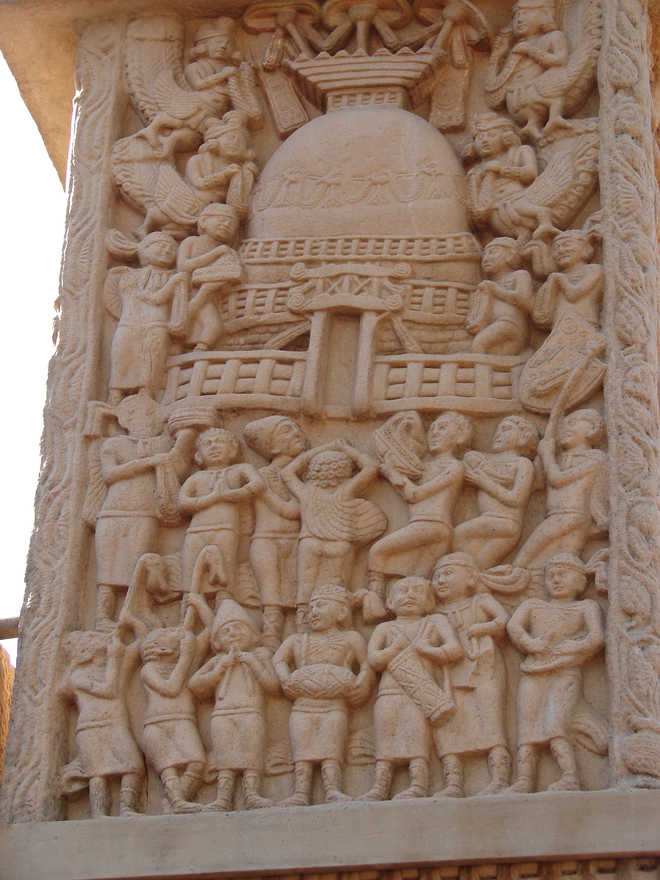
A cameo of the past: Devotees at the Stupa ruins
Hugh & Colleen Gantzer
The 91m-high hillock caught our eye. We were just 46 km from Bhopal retracing the journey done by Prince Ashoka, a millennia ago. He had fought a particularly bloody battle in Odisha. Later, dismayed by the carnage and cries of wounded men and horses, Ashoka had renounced the sword and accepted the gentle faith of Buddhism. Now, like most fresh converts, he was determined to proclaim his new religion for everyone to see. And so, atop the knoll, he had built a stupa and erected a monolithic pillar.
As we strolled up the winding path, and the Great Stupa grew before our eyes, we recalled that the Buddha, founder of the faith, was a religious revolutionary. As the guide book of the Archaeological Survey of India puts it:
...nowhere in Sanchi is the Buddha represented in his human form, his presence being denoted in the form of symbols such as a caparisoned horse without a rider but with an umbrella held above; a throne; the dharma-chakra; a promenade, footprints and the tri-ratna.
This, however, is not quite true. Against a ledge in the Great Stupa, there are four images of the seated Buddha, and in temple 45, there are at least two such images. As Buddhism veered away from the austere Hinayana creed to the more liberal Mahayana, symbols gave way to human representations.
The Great Stupa dominates Sanchi. Stupas were, originally, just mounds of rocks enclosing relics of the dead. Later, these became objects of veneration in their own right. The gateways were added in the first century BC by rich devotees. On every visit to Sanchi, we have discovered something new in these wonderful gateways. Stone dwarves strain under the weight these are bearing; women with fulsome figures lean out; we have even located a Greek sentry with a spear, evidence of India’s international relations. The carvings depict the history of Buddhism, episodes from the life of the Buddha, illustrations of the old Jataka Tales relating to the earlier incarnations of the Buddha; and general scenes and decorations, some capturing a sensuality that we have not, usually, associated with Buddhism particularly as Sanchi was a major monastic establishment.
We also walked down the slope to the ruins of the monasteries and tried to imagine what it must have been like in its heyday. Chants would have filled the halls, the fragrance of incense would have graced the air, strawberry-robed monks would have hurried past clip-clopping in their wooden-clogs, carrying flowers, water and lighted lamps to the temples around the stupas. And winding through these shaven-headed monks were the rich merchants of Videsha in their silks, cosseted by their retinues of umbrella carriers, fly-whisk bearers, fan wielders, perfumers sprinkling scented water; and graceful women stepping lightly out of palanquins, their faces and bodies covered in diaphanous garments, more revealing than concealing, in the hot glare of the heart of India.
No one quite knows, however, why Sanchi was abandoned. In all likelihood, since there was now little difference between Buddhism and Hinduism, its very reason for existence had ceased. There are no Buddhist monuments dating to the 13th century in Sanchi. There are, however, a number of Brahmanical plaques, of this period, displayed in the Site Museum.
We drove out 16 km to a cliff made out of the step-like formations of the Deccan Traps. These were caused by lava welling out through fissures in the earth. In this basaltic rock, devout Hindus excavated the Udaigiri Caves and carved evocative sculptures on their walls and entrances. We were particularly impressed by the carvings on Cave 5 showing the heroic figure of the boar incarnation of Vishnuraising the Earth from the abyss. But there is a much greater significance to these caves than their sculptures. According to architect and historian, Satish Grover, “The earliest Brahminical or Hindu shrine was nothing more than a cell to house an image. Other rituals were still conducted in the open air.”
And then he adds:
The oldest shrines of the Hindu religion, true to the national genius, are … a group of caves carved out of a mountain side at Udaygiri, near ancient Sanchi.



























